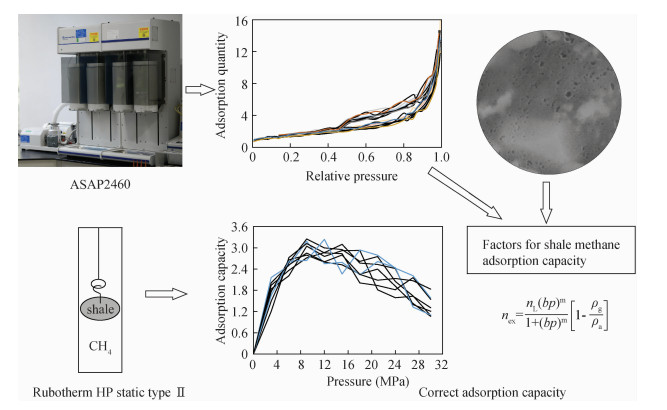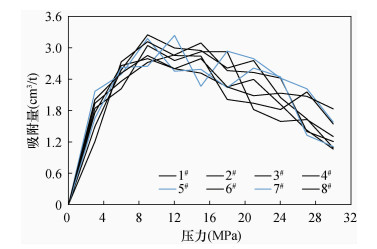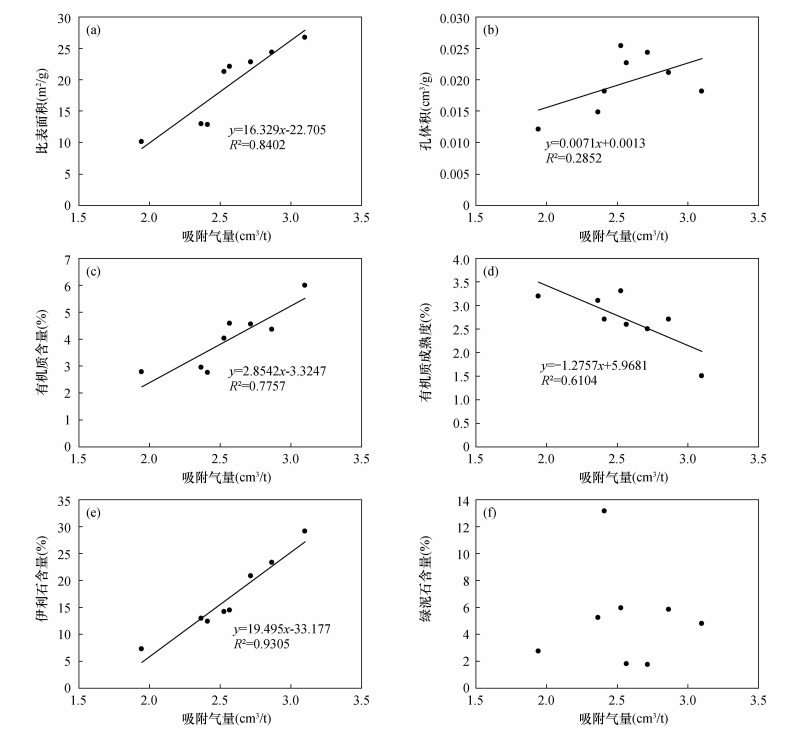Application of High-temperature Methane Adsorption Experiment to Study the Adsorption Capacity of Methane in Shales from the Wufeng Formation, Northeast Sichuan
-
摘要: 页岩甲烷吸附能力是决定页岩气井开采方案的重要参数,对评估页岩气藏潜力意义重大。干酪根类型、总有机碳含量、矿物组成、成熟度和孔径等是影响页岩吸附性能的因素,但针对高温高压下过剩吸附现象对页岩甲烷吸附能力影响的研究还需开展进一步的探索。为揭示四川盆地东北地区五峰组页岩甲烷吸附能力,本文通过场发射扫描电镜、低温氮气吸附和高压甲烷吸附实验,研究了高温高压下页岩的甲烷吸附能力,并分析了页岩孔隙结构等对页岩吸附能力的影响。结果表明:①五峰组页岩孔隙结构非均质性强,发育有机孔隙、粒(晶)间孔隙、粒(晶)内孔隙和粒(晶)间溶孔等多种孔隙;②比表面积平均为19.1282m2/g;孔体积平均为0.0195cm3/g;孔径平均为5.2226nm;③修正后的饱和吸附气量为2.56m3/t;④五峰组页岩甲烷吸附性能受控于比表面积、孔体积;有机质含量越大、有机质热演化程度越低,其甲烷吸附性能越强;⑤孔隙结构是影响页岩甲烷吸附能力的重要内因。同时指出低压条件下的实验吸附曲线不适合直接评价页岩甲烷吸附能力。要点
(1) 探索了过剩吸附现象对五峰组页岩甲烷吸附能力的影响。
(2) 揭示了孔隙结构是影响页岩的甲烷吸附能力的重要内因。
(3) 证明了低压条件下的吸附曲线不适合直接评价五峰组页岩甲烷吸附能力。
HIGHLIGHTS(1) The effect of excess adsorption on adsorption capacity of the methane in the Wufeng Formation shale was explored.
(2) The pore structure was an important internal factor that affects the shale methane adsorption capacity.
(3) It was proved that the adsorption curve under low pressure conditions was not suitable for directly evaluating the adsorption capacity of methane in the Wufeng Formation shale.
Abstract:BACKGROUNDShale methane adsorption capacity is not only a significant parameter to determine the exploration and exploitation plan, but also a critical criterion to evaluate the potential of a shale gas reservoir. Types of kerogen, total organic carbon content, mineral composition, maturity, and pore size are factors that affect shale adsorption performance; however, not enough attention is being focused on the influence of excess adsorption under high temperature and high pressure on shale methane adsorption capacity.OBJECTIVESTo reveal the influence of excess adsorption under high temperature and high pressure on the adsorption capacity of methane from the Wufeng Formation shale in Northeast Sichuan.METHODSBased on methods of field emission scanning electron microscopy, low-temperature nitrogen adsorption test, and high-pressure methane adsorption test, the shale methane adsorption capacity under high temperature and pressure was studied, and the influence of shale pore structure on the shale adsorption capacity was analyzed.RESULTSThe types of pore structure in the Wufeng Formation shale were diverse, including organic, intergranular, intercrystalline, and intergranular dissolved pore. The average specific surface area was 19.1282m2/g, while average pore volume and pore diameters were 0.0195cm3/g and 5.2226nm, respectively. The corrected adsorption capacity of shale in the Wufeng Formation was 2.56m3/t. The Wufeng Formation shale methane adsorption performance was controlled by specific surface area and pore volume. The larger the organic matter content, the lower the thermal evolution of organic matter and the stronger its methane adsorption performance. Pore structure was an important internal factor affecting the shale methane adsorption capacity.CONCLUSIONSThe experimental adsorption curve under low pressure is not suitable for directly evaluating the shale methane adsorption capacity.
-
Keywords:
- Northeast Sichuan /
- the Wufeng Formation /
- shale /
- methane /
- adsorption capacity /
- pore /
- supercritical state
-
甲烷,系统名为“碳烷”,无色无臭气体,熔点为-182.5℃,沸点为-161.5℃。页岩气主要成分为甲烷,是一种非常规油气资源。2014年以来我国页岩气勘探开发已经开始规模化开发[1-3]。页岩中发育大量的纳米级孔隙,为页岩气赋存提供主要场所;页岩气主要由赋存在孔隙中和裂缝中的游离气,以及吸附在有机质和矿物表面的吸附气组成(吸附气占20%~80%)[4-5];在页岩气开发过程中吸附气逐步析出,吸附气量的高低不仅决定着页岩地质储量的优劣,更是气井后期稳产的关键因素。因此,研究页岩甲烷吸附能力对评估页岩气藏潜力和页岩气井高产稳产具有重要意义。另外,页岩储层属于超低孔、特低渗非常规储层,页岩甲烷吸附能力主要受矿物组分、有机质含量、有机质的热演化程度、孔隙结构等因素影响[5-6]。页岩的孔隙结构复杂,不同的储集空间类型和微观结构特征对页岩吸附性能和产能的贡献不同[6]。研究孔隙结构对页岩甲烷吸附能力的影响,进而评价页岩气成藏资源量具有重要的意义[7-10]。
目前对页岩的甲烷吸附能力的研究受到了国内外学者的广泛关注,其研究方法已经从定性描述转向定量表征[11-13]。常用的研究方法主要为基于等温吸附实验和经典Langmuir方程的拟合算法。由于受限于实验设备的测试能力,甲烷吸附实验的温度普遍低于真实地层温度,压力也多低于15MPa。但是甲烷在页岩储层内为超临界状态且在页岩表面的吸附是超临界吸附[14-15],甲烷的吸附气量会出现过剩吸附现象,经典的Langmuir方程并不适合描述超临界状态下的等温吸附曲线[16-17]。因此用经典的Langmuir方程拟合过剩吸附曲线会高估页岩的真实甲烷吸附能力。
场发射扫描电镜可以获得具有立体感的页岩表面超微形貌信息,被广泛应用于半定量-定量识别页岩孔隙类型。低温氮气吸附实验结果可进一步表征页岩孔隙类型,被广泛用于获得页岩的比表面积、孔体积和孔径等参数。相比低温氮气吸附实验,高温甲烷吸附实验的测试条件更加符合页岩气藏的实际地质条件,结合Langmuir-Freundlich方程被广泛应用于拟合页岩等温吸附线,进而评价页岩甲烷吸附能力。本文以川东北地区五峰组页岩的岩心为研究对象,通过场发射扫描电镜研究页岩的孔隙结构特征,通过低温氮气吸附实验测量页岩的孔隙结构、比表面积和孔体积等;采用高温甲烷吸附实验测试页岩样品的吸附气量,并基于修正的三元Langmuir-Freundlich(L-F)方程拟合高温甲烷过剩吸附曲线,计算地层压力条件下页岩的饱和吸附气量;进一步分析地层温度和压力条件下影响页岩甲烷吸附能力的因素,为评估页岩气藏的勘探开发潜力、决定页岩气井开采方案和保持页岩气井高产稳产提供参数支持。
1. 实验部分
1.1 样品特征
实验样品来自四川盆地东北部的ZW-5页岩气评价井。取样层位为五峰组顶部,取样深度为2210.46~2272.45m,取样间距为5~10m。五峰组页岩处于过成熟阶段,干酪根类型以Ⅰ型为主。样品的基础地球化学和矿物组分数据(表 1)显示:样品的总有机碳(TOC)含量为1.18%~4.64%,平均为2.22%,为富有机质页岩;有机质成熟度(Ro)为2.89%~3.19%,平均为3.02%;石英含量为33.47%~61.35%,平均为46.39%;长石含量为8.24%~28.47%,平均为15.53%;碳酸盐矿物(方解石和白云石)含量为4.16%~20.18%,平均为9.20%;黏土矿物含量平均为21.90%,主要为伊利石,其平均含量约16.77%,见少量绿泥石,平均含量为5.13%;样品主要由石英、长石、黏土矿物以及部分碳酸盐矿物组成。
表 1 五峰组页岩样品的基础地球化学和矿物组分数据Table 1. Basic geochemical and mineral composition data for shale samples, the Wufeng Formation样品编号 有机碳含量(%) 镜质反射率(%) 矿物成分含量(%) 石英 长石 方解石 白云石 黄铁矿 伊利石 绿泥石 1 1.18 3.02 40.11 28.47 10.42 3.47 3.44 7.29 2.72 2 1.78 3.09 47.34 18.32 3.19 3.35 3.24 12.88 5.20 3 1.58 3.17 38.18 13.28 8.04 12.14 2.87 12.28 13.12 4 3.78 3.19 33.47 18.49 7.4 2.49 5.42 14.20 5.94 5 4.64 2.96 61.14 9.1 5.98 2.41 4.24 14.40 1.80 6 3.90 2.89 61.35 8.24 2.85 1.87 3.02 20.80 1.71 7 3.13 2.90 44.45 11.42 3.38 2.46 0.00 23.24 5.80 8 3.91 2.94 45.08 16.88 2.15 2.01 0.00 29.05 4.76 1.2 实验方法
1.2.1 场发射扫描电镜分析
在采用高分辨率扫描电镜观察页岩样品微孔隙结构特征时,页岩样品表面的高低起伏变化会影响观察结果的准确性[18-19]。因此为了消除误差、满足样品表面必须保持光滑的要求,在使用场发射扫描电镜观察样品之前,采用离子束抛光技术对页岩样品进行预处理[20-21]。
本次测试方法遵守SY/T 5162—2014《岩石样品扫描电子显微镜分析方法》和SY/T 6189—1996《岩石矿物能谱定量分析方法》。实验样品预处理采用的仪器为GATAN氩离子抛光仪,场发射扫描电镜为四川省科源工程技术测试中心的ZEISS SIGMA场发射扫描电子显微镜和能谱仪。
1.2.2 低温氮气吸附实验
低温氮气吸附实验的测试设备为四川省科源工程技术测试中心的ASAP2460型比表面物理吸附仪。实验环境为-195.8℃,测试方法遵守GB/T 19587—2004《气体吸附BET法测定固态物质比表面积》。实验前将1~3g样品在150℃环境下进行4~6h的抽真空脱气处理以除去材料表面吸附的气体;脱气结束后将样品研磨粉碎至60~80目后固定在仪器上依次回填氦气和氮气;采用氮气作为吸附质气体,在氮气温度下逐步改变压力大小测定相应的吸附气量和脱附气量,即绘制等温吸附-脱附曲线。根据密度泛函原理,计算五峰组页岩样品的比表面积、孔体积与孔径等基础参数。
1.2.3 高温甲烷吸附实验
高温甲烷吸附实验采用四川省科源工程技术测试中心的Rubotherm ISOSORP HP Static Ⅱ型重量法高温吸附仪进行测试,仪器的精度为0.00001g,测试方法参照GB/T 19560—2008《煤的高压等温吸附试验方法》。本次实验测试压力为30MPa,测试温度为50℃。测试步骤如下:首先,制取粒度为60~80目的岩样,烘干处理,随后将样品固定在仪器上回填氦气(将样品中残余气体排出)。然后,通入氦气进行浮力测试,在0~30MPa压力范围内测试10个压力点并记录仪器测量值。其次,通入甲烷(纯度为99.99%)进行吸附试验,在测试过程中10个压力点的平衡时间应大于2h以保证吸附过程中压力稳定。最后,可得到地层温度下、地层压力条件下仪器测量值。通过本文提出的基于三元Langmuir-Freundlich(L-F)方程的页岩吸附模型计算,便可得到页岩的饱和吸附气量。
2. 结果与讨论
2.1 页岩微观孔隙结构镜下特性
通过场发射扫描电镜观察五峰组页岩样品微观孔隙结构特征(图 1),结果表明五峰组页岩孔隙类型为有机孔隙和无机孔隙。其中,有机孔隙主要分布在有机质内部或边缘,仅有少量的有机孔分布在有机质与无机矿物之间;有机质内部的孔隙多呈椭圆状;有机质边缘的孔隙呈狭缝状(图 1a~c)。分析成因为:当温度、压力、有机质类型一定时,有机孔隙的发育主要受有机质演化程度影响。本次测试样品处于过成熟阶段,位于生气窗期,裂解气量增加,有机孔隙发育。有机质边缘孔隙主要是由于有机质生烃过程中发生质量亏损,总体积降低,有机质收缩而造成的[22-23]。此外,偶见少量有机孔隙分布在有机质与黏土矿物或黄铁矿等无机矿物边界处(图 1d, e)。这类孔隙的形态主要受无机矿物的影响,黄铁矿的含量及其形态在一定程度上对干酪根反应的活化能、反应速率都有一定的催化作用[24-25];有机质与无机矿物相接触的边界处是力学上的薄弱位置,有机质自身的收缩性同样会产生破裂,形成现今的有机质边缘孔隙。
![]() 图 1 五峰组页岩电镜下的微观孔隙结构特征a—有机孔隙大量发育在有机质内部,呈椭圆状孤立分布,见少量有机孔连通;b—有机边缘孔主要发育在有机质颗粒与无机矿物粒间;c—有机孔隙,见部分有机质孔连通扩大;d—有机孔隙,主要分布在有机质与黏土矿物粒间,受黏土矿物形态影响呈不规则状分布;e—有机孔隙,分布在黄铁矿颗粒内,相互连通呈不规则状分布;f—粒间溶孔,分布在长石颗粒边缘,呈不规则状分布,偶见部分呈串珠状分布;g—粒间溶孔,主要分布在伊利石层间,受伊利石形态影响呈狭长形分布;h—黄铁矿晶间孔,草莓状,受黄铁矿晶体形态影响呈不规则状分布。Figure 1. Characteristics of microscopy pores in shales under SEM, the Wufeng Formation
图 1 五峰组页岩电镜下的微观孔隙结构特征a—有机孔隙大量发育在有机质内部,呈椭圆状孤立分布,见少量有机孔连通;b—有机边缘孔主要发育在有机质颗粒与无机矿物粒间;c—有机孔隙,见部分有机质孔连通扩大;d—有机孔隙,主要分布在有机质与黏土矿物粒间,受黏土矿物形态影响呈不规则状分布;e—有机孔隙,分布在黄铁矿颗粒内,相互连通呈不规则状分布;f—粒间溶孔,分布在长石颗粒边缘,呈不规则状分布,偶见部分呈串珠状分布;g—粒间溶孔,主要分布在伊利石层间,受伊利石形态影响呈狭长形分布;h—黄铁矿晶间孔,草莓状,受黄铁矿晶体形态影响呈不规则状分布。Figure 1. Characteristics of microscopy pores in shales under SEM, the Wufeng Formation无机孔隙可划分为粒(晶)间孔隙、粒内孔隙、粒(晶)间溶孔,扫描电镜下观察到的有黏土矿物粒间孔、黄铁矿晶间孔等。黏土矿物粒间孔多呈狭长形或不规则状,其形状主要受黏土矿物发育形态影响,样品中黏土矿物主要为伊利石和绿泥石,主要是由于样品热演化程度较高,页岩的成岩作用较强,蒙脱石等黏土矿物相继转换为层间矿物,层间矿物含量随着有机质的热演化程度的升高而降低,继而蒙脱石转化为伊利石、绿泥石等矿物[26],因此多见伊利石粒间孔(图 1f, g)。部分黄铁矿晶间孔呈不规则状分布,主要是由于黄铁矿单晶体之间堆积不紧密而形成,其形状分布主要受黄铁矿颗粒形态的影响(图 1h)。
2.2 低温氮气吸附曲线特征
场发射扫描电镜被广泛应用于半定量识别页岩孔隙类型,但低温氮气吸附实验可进一步表征页岩孔隙类型,以及获得页岩的比表面积、孔体积和孔径等参数。本次实验以相对压力(P/P0)为横坐标、吸附气量为纵坐标的低温氮气吸附-脱附曲线,可以反映页岩的孔隙结构、比表面积和孔容等信息。五峰组页岩的低温氮气吸附-脱附曲线(图 2)显示:8个样品的吸附-脱附曲线形态均呈现典型的反S形;根据Brunauer-Deming-Beming-Teller(BDBT)分类法,样品的吸附-脱附曲线属于Ⅱ型。即:在相对压力小于0.4时,吸附气量快速升高,氮气分子由简单的单层吸附向复杂的多层吸附转化;在相对压力大于0.4时,出现“毛细管凝聚”作用,使吸附曲线与脱附曲线不重合,进而形成典型的回滞环。回滞环的特征可以表征测试样品中孔隙的基本形态[4-5]。根据IUPAC的分类,五峰组页岩的回滞环等温线属于H3偏H4型。回滞环类型表明:五峰组页岩的孔隙结构很不规整,具有平板狭缝结构、裂缝和楔形结构等。同时扫描电镜观察结果显示,五峰组页岩的纳米级孔隙形态各异:有机质内部的孔隙多呈椭圆状;有机质边缘的孔隙呈狭缝状;无机孔隙多呈狭长形或不规则状。因此,五峰组页岩的孔隙类型是多种孔隙结构的组合。
页岩孔隙的比表面积是衡量页岩岩石基质吸附特性的重要参数,孔体积和孔径也对甲烷吸附能力有较大的贡献[18, 27]。根据密度泛函原理(DFT),基于氮气吸附数据计算得到五峰组页岩孔隙结构参数(表 2)。本次实验的五峰组页岩样品的比表面积为10.1165~26.6449m2/g,平均为19.1282m2/g;孔体积为0.0121~0.0254cm3/g,平均为0.0195cm3/g;孔径为4.3146~6.4301nm,平均为5.2226nm。朱汉卿等[4]研究显示五峰组页岩样品比表面积为16.846~63.738m2/g,孔体积为0.050~0.092cm3/g,吸附气量为0.0670~0.2202m3/t。在比表面积和孔体积近似相同的情况下,同为五峰组页岩样品的吸附气量差异较大(吸附气量为1.9424~3.0964m3/t),因此影响页岩甲烷吸附能力的因素可能还有孔隙结构等其他因素。
表 2 五峰组页岩氮气吸附-脱附测试结果Table 2. Nitrogen adsorption-desorption test results of shale, the Wufeng Formation样品编号 比表面积(m2/g) 孔体积(cm3/g) 平均孔径(nm) 1 10.1165 0.0121 6.0117 2 12.9502 0.0148 5.9612 3 12.8416 0.0181 6.4301 4 21.2751 0.0254 4.4651 5 22.1228 0.0226 4.3706 6 22.7677 0.0243 5.1415 7 24.3068 0.0211 5.0861 8 26.6449 0.0181 4.3146 2.3 高温甲烷吸附曲线特征
8个页岩样品的高温高压(50℃,30MPa)甲烷等温吸附线具有相似特征,分布范围为吸附气量1.9424~3.0964m3/t(图 3)。即在温度一定时,吸附气量随着压力的升高而增加,当压力增加到一定程度,吸附气量达到饱和,不再增加,甚至出现下降趋势。吸附曲线可以划分为3个区间:当吸附压力小于10MPa时,甲烷吸附气量随着压力的增加而快速增加;过剩吸附气量在压力为10MPa附近出现,平均甲烷过剩吸附气量为3.04cm3/t;压力大于10MPa时,甲烷吸附气量逐渐达到饱和且随着压力的增加而下降。Chalmers等(2012)[28]、周尚文等(2017)[29]指出甲烷在实验温度下为超临界流体,发生的吸附为超临界吸附;页岩中超临界甲烷的等温吸附曲线在压力较大时呈现下降趋势,主要是由于超临界流体的过剩吸附气量导致而成[30-31]。
3. 页岩甲烷吸附能力分析
3.1 页岩吸附模型
张晓明等(2017)[32]通过经典的Langmuir模型拟合过剩吸附曲线研究页岩甲烷吸附能力,但该模型假设吸附限于单分子层、不发生多分子层吸附;吸附剂表面均匀、所有吸附位的吸附能一样大;分子之间没有相互作用;然而页岩(吸附剂)并不存在这种理想状态。朱汉卿等(2018)[33]通过四元Langmuir-Freundlich(L-F)模型研究高温(90℃)高压(30MPa)条件下页岩甲烷吸附能力,但该模型中的气体饱和蒸汽压的校正系数难以确定,不利于实际计算。
通过等温吸附仪直接测试获取的是页岩的过剩吸附气量(Gibbs吸附量、视吸附量或表观吸附量),而绝对吸附气量则为样品实际吸附气量。从甲烷的密度-温度、压力相图可知,低压时(< 6MPa),甲烷游离气密度很低,过剩吸附气量与绝对吸附气量基本接近,现有的等温吸附测试标准将测试压力较低时的过剩吸附气量近似为绝对吸附气量使用;当高压时(>20MPa),甲烷游离气密度会显著增加,此时必须考虑校正过剩吸附气量。
基于Gibbs吸附理论可知,过剩吸附气量mex与绝对吸附气量mabs之间的关系为:
$ m_{\mathrm{abs}}=\frac{m_{\mathrm{ex}}}{1-\frac{\rho_{\mathrm{g}}}{\rho_{\mathrm{a}}}} $
(1) 式中:mex为过剩吸附气量,g;mabs为绝对吸附气量,g;ρg为不同压力点下甲烷气体的密度,g/cm3;ρa为甲烷吸附相密度,g/cm3。
考虑到高温高压条件下吸附相密度对页岩吸附性能的影响,Ross等[18](2009)将Gibbs吸附理论与Langmuir方程结合,提出了三元Langmuir-Freundlich(L-F)方程(式2):将吸附相密度作为待定参数,从数学优化的角度对等温吸附曲线进行优化和拟合,从而得到吸附相密度[29]。
$ n_{\mathrm{ex}}=\frac{n_{\mathrm{L}}(b p)^{m}}{1+(b p)^{m}}\left(1-\frac{\rho_{\mathrm{g}}}{\rho_{\mathrm{a}}}\right) $
(2) 式中:nex为平衡压力p时的过剩吸附气量,mmol/g;nL为最大吸附气量,mmol/g;b为与吸附剂和吸附质相关的常数;p为吸附实验的压力,MPa;m为表征吸附剂非均质性的参数,m≤1,当吸附剂具有理想表面时,m=1;ρg为不同压力点下甲烷气体的密度,g/cm3;ρa为甲烷吸附相密度,g/cm3。
该模型不仅修正了高压下吸附相的影响,而且修正了Langmuir方程中关于吸附位均匀分布的不合理假设,因此可以采用三元Langmuir-Freundlich(L-F)方程对页岩样品的等温吸附测试结果进行校正。结果显示:相比渝东南地区牛蹄塘组页岩样品的吸附气量范围为1.13~7.36m3/t,平均为2.66m3/t[5],川东北地区五峰组页岩样品的吸附气量主要分布在1.94~3.09m3/t,平均值为2.56m3/t,可见五峰组页岩吸附性能变化范围小、更加稳定。
3.2 页岩甲烷吸附能力的影响因素
前文研究表明在比表面积和孔体积近似相同的情况下,同为五峰组页岩样品的吸附气量差异较大。因此,影响页岩甲烷吸附能力的因素可能还有孔隙结构、有机质含量、有机质成熟度、黏土矿物类型和含量等其他因素。本实验通过相关性分析法研究以上因素和吸附气量的相关性,进而确定影响页岩甲烷吸附能力的因素。
(1) 孔隙结构
页岩的甲烷吸附能力不仅与温度、压力等因素有关,而且与页岩本身的孔隙结构同样关系紧密。页岩的比表面积和孔体积是表征页岩孔隙结构的有效方式之一[34]。分析本次实验的五峰组页岩样品比表面积、孔体积与吸附气量之间的关系可知:比表面积越大,吸附气量越大;孔体积越大,吸附气量越大(图 4a,b)。有机质颗粒本身具有很强的吸附性能,五峰组页岩中大量的有机质孔隙表面构成了页岩吸附甲烷的主要场所;五峰组页岩中大量的、连通的有机质孔隙增强了页岩的甲烷吸附能力。
(2) 有机质含量和有机质成熟度
本次分析结果表明测试样品有机碳含量与吸附气量之间存在较强的相关性(图 4c)。分析原因:随着有机质含量的增多,测试样品中发育有大量的有机孔,过成熟页岩中的有机质孔数量增大,样品比表面积值增大,从而提升了页岩整体的吸附能力(图 4d);此外有机碳含量高的泥页岩生气能力强,对应的单位体积泥页岩的含气量也就相对较高。
五峰组页岩的有机质成熟度平均为3.02%,处于过成熟阶段。扫描电镜下热演化程度较高的页岩中部分有机孔连通(图 1a、b、c),随着有机质热演化程度的增大,吸附气量呈减小趋势。五峰组页岩的有机质成熟度增大,对应的甲烷吸附位也减少,有机质成熟度通过改变页岩内的孔隙结构,改变页岩吸附性能。
(3) 黏土矿物的类型和含量
页岩的黏土矿物同样具有一定的吸附能力,不同的黏土矿物因晶体结构、颗粒大小等方面存在差异,其所形成的颗粒间、晶间、层间孔隙的大小及比表面也不同,因此具有不同的吸附气量[33, 35-36]。五峰组页岩中常见的黏土矿物主要为伊利石和绿泥石等。分析五峰组页岩样品的吸附气量与伊利石和绿泥石含量的关系可知,伊利石含量与吸附气量呈正相关(图 4e),绿泥石含量与吸附气量没有明显的相关性(图 4f)。五峰组页岩中的伊利石含量高低是其影响甲烷吸附能力的重要因素。
4. 结论
川东北地区五峰组页岩的孔隙类型主要为有机和无机孔隙两大类。有机孔隙分布在有机质内部或边缘,形态大多为椭圆状,部分呈狭缝状;无机孔隙有黏土矿物粒间孔、黄铁矿晶间孔、粒间溶孔等,形态多为狭长形或不规则状。五峰组页岩的孔隙类型是多种孔隙结构的混合。
五峰组页岩的等温吸附-脱附曲线属于Ⅱ型;压力为10MPa时出现过剩吸附现象,过剩吸附气量为3.04m3/t;地层压力条件下的页岩的真实饱和吸附气量为2.56m3/t;绝对吸附气量与过剩吸附气量的差值随着压力的增大而增大,低压条件下的实验吸附曲线不适合直接评价页岩甲烷吸附能力,否则将高估页岩甲烷吸附能力。相关性分析表明,孔隙结构是影响页岩甲烷吸附能力的重要内因,比表面积、孔体积和有机质含量与甲烷吸附能力之间存在正相关关系;页岩甲烷吸附能力与有机质热演化程度呈负相关。
-
图 1 五峰组页岩电镜下的微观孔隙结构特征
a—有机孔隙大量发育在有机质内部,呈椭圆状孤立分布,见少量有机孔连通;b—有机边缘孔主要发育在有机质颗粒与无机矿物粒间;c—有机孔隙,见部分有机质孔连通扩大;d—有机孔隙,主要分布在有机质与黏土矿物粒间,受黏土矿物形态影响呈不规则状分布;e—有机孔隙,分布在黄铁矿颗粒内,相互连通呈不规则状分布;f—粒间溶孔,分布在长石颗粒边缘,呈不规则状分布,偶见部分呈串珠状分布;g—粒间溶孔,主要分布在伊利石层间,受伊利石形态影响呈狭长形分布;h—黄铁矿晶间孔,草莓状,受黄铁矿晶体形态影响呈不规则状分布。
Figure 1. Characteristics of microscopy pores in shales under SEM, the Wufeng Formation
表 1 五峰组页岩样品的基础地球化学和矿物组分数据
Table 1 Basic geochemical and mineral composition data for shale samples, the Wufeng Formation
样品编号 有机碳含量(%) 镜质反射率(%) 矿物成分含量(%) 石英 长石 方解石 白云石 黄铁矿 伊利石 绿泥石 1 1.18 3.02 40.11 28.47 10.42 3.47 3.44 7.29 2.72 2 1.78 3.09 47.34 18.32 3.19 3.35 3.24 12.88 5.20 3 1.58 3.17 38.18 13.28 8.04 12.14 2.87 12.28 13.12 4 3.78 3.19 33.47 18.49 7.4 2.49 5.42 14.20 5.94 5 4.64 2.96 61.14 9.1 5.98 2.41 4.24 14.40 1.80 6 3.90 2.89 61.35 8.24 2.85 1.87 3.02 20.80 1.71 7 3.13 2.90 44.45 11.42 3.38 2.46 0.00 23.24 5.80 8 3.91 2.94 45.08 16.88 2.15 2.01 0.00 29.05 4.76 表 2 五峰组页岩氮气吸附-脱附测试结果
Table 2 Nitrogen adsorption-desorption test results of shale, the Wufeng Formation
样品编号 比表面积(m2/g) 孔体积(cm3/g) 平均孔径(nm) 1 10.1165 0.0121 6.0117 2 12.9502 0.0148 5.9612 3 12.8416 0.0181 6.4301 4 21.2751 0.0254 4.4651 5 22.1228 0.0226 4.3706 6 22.7677 0.0243 5.1415 7 24.3068 0.0211 5.0861 8 26.6449 0.0181 4.3146 -
位云生, 贾爱林, 何东博, 等.中国页岩气与致密气开发特征与开发技术异同[J].天然气工业, 2017, 37 (11):43-52. doi: 10.3787/j.issn.1000-0976.2017.11.006 Wei Y S, Jia A L, He D B, et al.Comparative analysis of development characteristics and technologies between shale gas and tight gas in China[J]. Natural Gas Industry, 2017, 37(11):43-52. doi: 10.3787/j.issn.1000-0976.2017.11.006
马永生, 蔡勋育, 赵培荣.中国页岩气勘探开发理论认识与实践[J].石油勘探与开发, 2018, 45(4):561-574. http://d.old.wanfangdata.com.cn/Periodical/syktykf201804003 Ma Y S, Cai X Y, Zhao P R.China's shale gas exploration and development:Understanding and practice[J]. Petroleum Exploration and Development, 2018, 45(4):561-574. http://d.old.wanfangdata.com.cn/Periodical/syktykf201804003
胡东风, 张汉荣, 倪楷, 等.四川盆地东南缘海相页岩气保存条件及其主控因素[J].天然气工业, 2014, 34(6):17-23. doi: 10.3787/j.issn.1000-0976.2014.06.003 Hu D F, Zhang H R, Ni K, et al.Main controlling factors for gas preservation conditions of marine shales in southeastern margins of the Sichuan Basin[J]. Natural Gas Industry, 2014, 34(6):17-23. doi: 10.3787/j.issn.1000-0976.2014.06.003
朱汉卿, 贾爱林, 位云生, 等.昭通示范区龙马溪组页岩微观孔隙结构特征及吸附能力[J].油气地质与采收率, 2018, 25(4):1-6. http://d.old.wanfangdata.com.cn/Periodical/yqdzycsl201804001 Zhu H Q, Jia A L, Wei Y S, et al.Characteristics of microscopic pore structure and methane adsorption capacity of shale in the Longmaxi Formation in the Zhaotong Area[J]. Petroleum Geology and Recovery Efficiency, 2018, 25(4):1-6. http://d.old.wanfangdata.com.cn/Periodical/yqdzycsl201804001
孙梦迪, 于炳松, 陈颂, 等.渝东南地区下寒武统牛蹄塘组页岩储层特征及甲烷吸附能力——以渝科1井和酉科1井为例[J].东北石油大学学报, 2015, 39(1):69-79. doi: 10.3969/j.issn.2095-4107.2015.01.009 Sun M D, Yu B S, Chen S, et al.The reservoir characteristics and adsorption capacity of the Lower Cambrian Niutitang Formation shale in southeast of Chongqing:A case study of Well Yuke1 and Well Youke1[J]. Journal of Northeast Petroleum University, 2015, 39(1):69-79. doi: 10.3969/j.issn.2095-4107.2015.01.009
魏志红, 魏祥峰.页岩不同类型孔隙的含气性差异——以四川盆地焦石坝地区五峰组—龙马溪组为例[J].天然气工业, 2014, 34(6):37-41. doi: 10.3787/j.issn.1000-0976.2014.06.006 Wei Z H, Wei X F.Comparison of gas-bearing property between different pore types of shale:A case from the Upper Ordovician Wufeng and Longmaxi Fms in the Jiaoshiba Area, Sichuan Basin[J]. Natural Gas Industry, 2014, 34(6):37-41. doi: 10.3787/j.issn.1000-0976.2014.06.006
王香增, 张丽霞, 李宗田, 等.鄂尔多斯盆地延长组陆相页岩孔隙类型划分方案及其油气地质意义[J].石油与天然气地质, 2016, 37(1):1-7. http://www.wanfangdata.com.cn/details/detail.do?_type=perio&id=syytrqdz201601001 Wang X Z, Zhang L X, Li Z T, et al.Pore type classification scheme for continental Yanchang Shale in Ordos Basin and its geological significance[J]. Oil & Gas Geology, 2016, 37(1):1-7. http://www.wanfangdata.com.cn/details/detail.do?_type=perio&id=syytrqdz201601001
曹茜, 周文, 陈文玲, 等.鄂尔多斯盆地南部延长组长7段陆相页岩气地层孔隙类型、尺度及成因分析[J].矿物岩石, 2015, 35(2):90-97. http://d.old.wanfangdata.com.cn/Periodical/kwys201502011 Cao Q, Zhou W, Chen W L, et al.Analysis of pore types, sizes and genesis in continental shale gas reservoir of Chang 7 of Yanchang Formation, Ordos Basin[J]. Journal of Mineral Petrology, 2015, 35(2):90-97. http://d.old.wanfangdata.com.cn/Periodical/kwys201502011
张廷山, 杨洋, 龚其森, 等.四川盆地南部早古生代海相页岩微观孔隙特征及发育控制因素[J].地质学报, 2014, 88(9):1728-1740. http://d.old.wanfangdata.com.cn/Periodical/dizhixb201409009 Zhang Y S, Yang Y, Gong Q S, et al.Characteristics and mechanisms of the micro-pores in the Early Palaeozoic Marine Shale, Southern Sichuan Basin[J]. Acta Geologica Sinica, 2014, 88(9):1728-1740. http://d.old.wanfangdata.com.cn/Periodical/dizhixb201409009
刘尧文, 王进, 张梦吟, 等.四川盆地涪陵地区五峰—龙马溪组页岩气层孔隙特征及对开发的启示[J].石油实验地质, 2018, 40(1):44-50. http://www.wanfangdata.com.cn/details/detail.do?_type=perio&id=sysydz201801007 Liu Y W, Wang J, Zhang M Y, et al.Pore features of shale gas layer in Wufeng—Longmaxi Formation in Fuling area of Sichun Basin and the application to development[J]. Petroleum Geology & Experiment, 2018, 40(1):44-50. http://www.wanfangdata.com.cn/details/detail.do?_type=perio&id=sysydz201801007
帅琴, 黄瑞成, 高强, 等.页岩气实验测试技术现状与研究进展[J].岩矿测试, 2012, 31(6):931-938. doi: 10.3969/j.issn.0254-5357.2012.06.003 Shuai Q, Huang R C, Gao Q, et al.Research development of analytical techniques for shale gas[J]. Rock and Mineral Analysis, 2012, 31(6):931-938. doi: 10.3969/j.issn.0254-5357.2012.06.003
白名岗, 夏响华, 张聪, 等.场发射扫描电镜及PerGeos系统在安页1井龙马溪组页岩有机质孔隙研究中的联合应用[J].岩矿测试, 2018, 37(3):225-234. doi: 10.15898/j.cnki.11-2131/td.201803260030 Bai M G, Xia X H, Zhang C, et al.Study on shale organic porosity in the Longmaxi Formation, AnYe-1 Well using field emission-scanning electron microscopy and PerGeos system[J]. Rock and Mineral Analysis, 2018, 37(3):225-234. doi: 10.15898/j.cnki.11-2131/td.201803260030
王羽, 金婵, 汪丽华, 等.应用氩离子抛光-扫描电镜方法研究四川九老洞组页岩微观孔隙特征[J].岩矿测试, 2015, 34(3):278-285. doi: 10.15898/j.cnki.11-2131/td.2015.03.003 Wang Y, Jin C, Wang L H, et al.Characterization of pore structures of Jiulaodong Formation shale in the Sichuan Basin by SEM with Ar-ion milling[J]. Rock and Mineral Analysis, 2015, 34(3):278-285. doi: 10.15898/j.cnki.11-2131/td.2015.03.003
Gasparik M, Ghanizadeh A, Bertier P, et al.High-pressure methane sorption isotherms of black shales from the Netherlands[J]. Energy & Fuels, 2012, 26(8):4995-5004. http://www.wanfangdata.com.cn/details/detail.do?_type=perio&id=0ec5ad23d44c09f6c58a54c78b57bf22
Cheng M, Li G S, Chen L J, et al.Mechanisms analysis of shalegas supercritical adsorption and modeling of isorption adsorption[J]. Journal of China Coal Society, 2014, 39(Supplement1):179-183.
Zhou L, Zhou Y P, Li M, et al.Experimental and modeling study of the adsorption of supercritical methane on a high surface activated carbon[J]. Langmuir, 2000, 16(14):5955-5959. doi: 10.1021/la991159w
Zhang T W, Geoffrey S E, Stephen C R, et al.Effect of organic matter type and thermal maturity on methane adsorption in shale gas systems[J]. Organic Geochemistry, 2012, 47:120-131. doi: 10.1016/j.orggeochem.2012.03.012
Ross D J K, Bustin R M.The importance of shale composition and pore structure upon gas storage potential of shale gas reservoirs[J]. Marine and Petroleum Geology, 2009, 26(6):916-927. doi: 10.1016/j.marpetgeo.2008.06.004
Rahman M U, Kazi T G, Shaikh H, et al.Fractionation of manganese in soil samples collected from the Lakhra Coal Field in Pakistan using two modes of atomic absorption spectrometry[J]. Atomic Spectroscopy, 2018, 39(6):258-263.
Lashari A A, Kazi T G, Ali J, et al.Evaluation of sequential extraction schemes for the ETAAS determination of cadmium concentrations in coal samples from the Thar Coalfield, Pakistan[J]. Atomic Spectroscopy, 2018, 39(5):203-209.
Satyanarayanan M, Balaram V, Sawant S S, et al.Rapid determination of REEs, PGEs, and other trace elements in geological and environmental materials by high resolution inductively coupled plasma mass spectrometry[J]. Atomic Spectroscopy, 2018, 39(1):1-15. http://www.wanfangdata.com.cn/details/detail.do?_type=perio&id=399d63251e1afd27679392d6e00fdd4d
王运海.四川盆地平桥地区五峰—龙马溪组页岩微观孔隙特征研究[J].石油实验地质, 2018, 40(3):337-344. http://www.wanfangdata.com.cn/details/detail.do?_type=perio&id=sysydz201803006 Wang Y H.Micro-pore characteristics of shale from Wufeng—Longmaxi Formations in Pingqiao area, Sichuan Basin[J]. Petroleum Geology & Experiment, 2018, 40(3):337-344. http://www.wanfangdata.com.cn/details/detail.do?_type=perio&id=sysydz201803006
胡华.黑色页岩中黄铁矿与有机质含量的关系及勘探意义[D].荆州: 长江大学.2017. Hu H.Study on the Relationship of Pyrite and Content of Organic Matter in Marine Black Shale and Its Significance for Shale Gas Exploration[D]. Jingzhou: Yangtze University, 2017.
张景廉, 张平中.黄铁矿对有机质成烃的催化作用讨论[J].地球科学进展, 1996(3):282-287. doi: 10.3321/j.issn:1001-8166.1996.03.009 Zhang J L, Zhang P Z.A discussion of pyrite catalysis on the hydrocarbon generation process[J]. Advance in Earth Sciences, 1996(3):282-287. doi: 10.3321/j.issn:1001-8166.1996.03.009
马存飞, 董春梅, 栾国强, 等.苏北盆地古近系页岩有机质孔发育特征及影响因素[J].中国石油大学学报(自然科学版), 2017, 41(3):2-13. http://www.wanfangdata.com.cn/details/detail.do?_type=perio&id=sydxxb201703001 Ma C F, Dong C M, Luan G Q, et al.Characteristics and its influencing factors of organic-matter pores in Paleogene Shale, Subei Basin[J]. Journal of China University of Petroleum, 2017, 41(3):2-13. http://www.wanfangdata.com.cn/details/detail.do?_type=perio&id=sydxxb201703001
周理, 吕昌忠, 王怡林, 等.述评超临界温度气体在多孔固体上的物理吸附[J].化学进展, 1999, 11(3):221-226. doi: 10.3321/j.issn:1005-281X.1999.03.001 Zhou L, Lü C Z, Wang Y L, et al.Physisorption of gases on porous solids at above-critical temperatures[J]. Progess in Chemistry, 1999, 11(3):221-226. doi: 10.3321/j.issn:1005-281X.1999.03.001
Chalmers G R L, Bustin R M.The organic matter distribution and methane capacity of the Lower Cretaceous strata of Northeastern British Columbia, Canada[J]. International Journal of Coal Geology, 2007, 70(1-3):223-239. doi: 10.1016/j.coal.2006.05.001
Chalmers G R, Bustin R M, Power I M.Characterization of gas shale pore systems by porosimetry, pycnometry, surface area, and field emission scanning electron microscopy/transmission electron microscopy image analyses:Examples from the Barnett, Woodford, Haynesville, Marcellus, and Doig units[J]. AAPG Bulletin, 2012, 96(6):1099-1119. doi: 10.1306/10171111052
周尚文, 李奇, 薛庆华, 等.页岩容量法和重量法等温吸附实验对比研究[J].化工进展, 2017, 36(5):1690-1697. http://d.old.wanfangdata.com.cn/Periodical/hgjz201705020 Zhou S W, Li Q, Xue Q H, et al.Comparative study on the volumetric and gravimetric method for isothermal adsorption experiment of shale[J]. Chemical Industry and Engineering Progress, 2017, 36(5):1690-1697. http://d.old.wanfangdata.com.cn/Periodical/hgjz201705020
Bose T K, Chahine R, Marchildon L, et al.New dielectric method for the measurement of physical adsorption of gases at high pressure[J]. Review of Scientific Instruments, 1987, 58(12):2279-2283. doi: 10.1063/1.1139336
鲍云杰, 邓模, 翟常博, 等.页岩对甲烷的吸附作用及其固气效应初步研究——以渝东南残留向斜为例[J].石油实验地质, 2016, 38(4):509-513. http://d.old.wanfangdata.com.cn/Periodical/sysydz201604014 Bao Y J, Deng M, Zhai C B, et al.Methane adsorption and sealing effects of shale—A case study of relict synclines in the Southeastern Chongqing[J]. Petroleum Geology & Experiment, 2016, 38(4):509-513. http://d.old.wanfangdata.com.cn/Periodical/sysydz201604014
张晓明, 石万忠, 舒志国, 等.涪陵地区页岩含气量计算模型及应用[J].地球科学——中国地质大学学报, 2017, 42(7):1157-1168. http://d.old.wanfangdata.com.cn/Periodical/dqkx201707012 Zhang X M, Shi W Z, Shu Z G, et al.Calculation model of shale gas content and its application in Fuling Area[J]. Editorial Committee of Earth Science—Journal of China University of Geosciences, 2017, 42(7):1157-1168. http://d.old.wanfangdata.com.cn/Periodical/dqkx201707012
朱汉卿, 贾爱林, 位云生, 等.蜀南地区富有机质页岩孔隙结构及超临界甲烷吸附能力[J].石油学报, 2018, 39(4):391-401. http://d.old.wanfangdata.com.cn/Periodical/syxb201804003 Zhu H Q, Jia A L, Wei Y S, et al.Pore structure and supercritical methane sorption capacity of organic-rich shales in Southern Sichuan Basin[J]. Acta Petrolei Sinica, 2018, 39(4):391-401. http://d.old.wanfangdata.com.cn/Periodical/syxb201804003
吴艳艳, 曹海虹, 丁安徐, 等.页岩气储层孔隙特征差异及其对含气量影响[J].石油实验地质, 2015, 37(2):231-236. http://www.wanfangdata.com.cn/details/detail.do?_type=perio&id=sysydz201502016 Wu Y Y, Cao H H, Ding A X, et al.Pore characteristics of a shale gas reservoir and its effect on gas content[J]. Petroleum Geology & Experiment, 2015, 37(2):231-236. http://www.wanfangdata.com.cn/details/detail.do?_type=perio&id=sysydz201502016
赵靖舟, 王芮, 耳闯.鄂尔多斯盆地延长组长7段暗色页岩吸附特征及其影响因素[J].地学前缘, 2016, 23(1):146-153. http://www.wanfangdata.com.cn/details/detail.do?_type=perio&id=dxqy201601013 Zhao J Z, Wang R, Er C.Adsorption characteristics of Chang 7 shale from the Triassic Yanchang Formation in Ordos Basin, and its controlling factor[J]. Earth Science Frontiers, 2016, 23(1):146-153. http://www.wanfangdata.com.cn/details/detail.do?_type=perio&id=dxqy201601013
郭少斌, 翟刚毅, 包书景, 等.干酪根及黏土单矿物对甲烷吸附能力的差异性[J].石油实验地质, 2017, 39(5):682-693. http://d.old.wanfangdata.com.cn/Periodical/sysydz201705014 Guo S B, Zhai G Y, Bao S J, et al.Difference of methane adsorption capacity of kerogen and clay minerals[J]. Petroleum Geology & Experiment, 2017, 39(5):682-693. http://d.old.wanfangdata.com.cn/Periodical/sysydz201705014
-
期刊类型引用(7)
1. 晁会霞,崔文玮,杨兴科,王冉,韩珂,杨宁,王仪卓. 南秦岭镇安棋盘沟钨矿床~(40)Ar-~(39)Ar年代学及其对印支末期成矿的指示. 大地构造与成矿学. 2023(03): 570-579 .  百度学术
百度学术
2. 段湘益,董王仓. 陕西南秦岭东阳大型钨矿床地质特征及成因探讨. 西北地质. 2021(03): 131-141 .  百度学术
百度学术
3. 段湘益,董王仓,黄凡,王海元,王文青,王洁明,蒙利. 陕西省钨钼多金属矿床时空分布规律及找矿方向. 金属矿山. 2021(10): 121-142 .  百度学术
百度学术
4. 黄凡,王登红,陈毓川,王岩,徐志刚,朱明玉,陈郑辉. 百年勘查成果与成矿规律之集大成——首部《中国矿产地质志》研编阶段性进展概述. 地质学报. 2020(01): 1-8+340+9-17 .  百度学术
百度学术
5. 代鸿章,王登红,刘丽君,黄凡,王成辉. 南秦岭镇安核桃坪钨铍矿床成矿时代及成矿模式探讨. 地质学报. 2019(06): 1342-1358 .  百度学术
百度学术
6. 代鸿章,王登红,刘丽君,黄凡,王成辉. 电子探针和微区X射线衍射研究陕西镇安钨-铍多金属矿床中祖母绿级绿柱石. 岩矿测试. 2018(03): 336-345 .  本站查看
本站查看
7. 王登红,王成辉,孙艳,李建康,刘善宝,饶魁元. 我国锂铍钽矿床调查研究进展及相关问题简述. 中国地质调查. 2017(05): 1-8 .  百度学术
百度学术
其他类型引用(1)



 下载:
下载:




 京公网安备 11010202008159号
京公网安备 11010202008159号